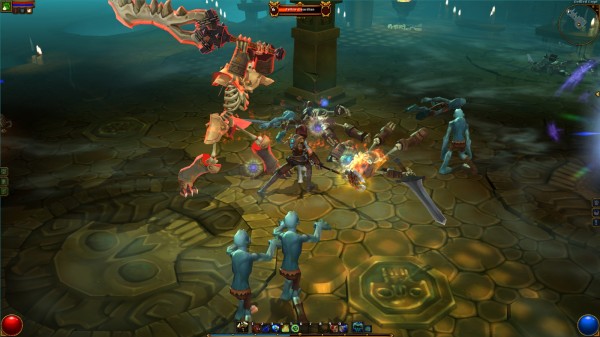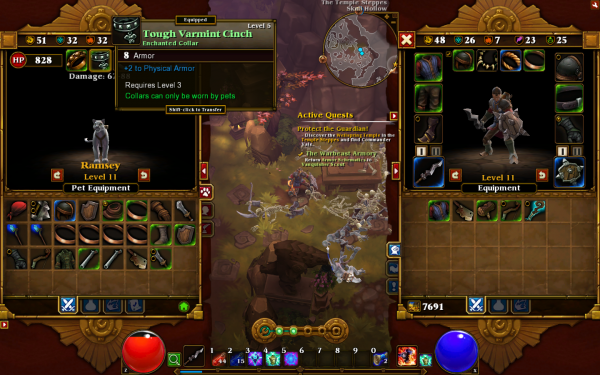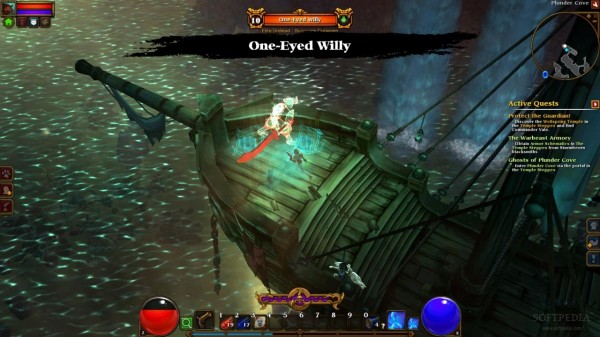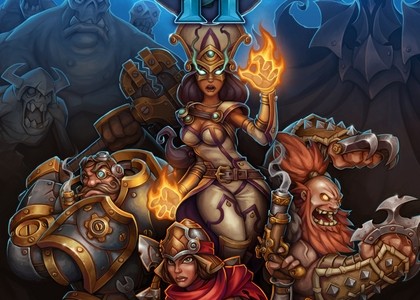I have a tentative abandon with role-playing games, in the same way that I can’t commit to watching Star Trek. I’m already a Star Wars Guy, right? I can’t get involved with Captain Picard and the Enterprise and that silly holodeck and that episode where Data has a British accent. I’m already married, Kirk, it just won’t work out. I only have so much to give.
 I’d like to sluff off the blame onto the age of instantaneous information and mobile gaming, which I could argue has ruined my appetite for deep fiction and complex game systems, but the reality is that I’m a guy with a job and friends. For me, Torchlight II has to fit into a framework without much free time and even less available mind share. And, oh by the way, Diablo III has already taken up residence in this house, and there’s just no more room for another click-loot-statistics dungeon.
I’d like to sluff off the blame onto the age of instantaneous information and mobile gaming, which I could argue has ruined my appetite for deep fiction and complex game systems, but the reality is that I’m a guy with a job and friends. For me, Torchlight II has to fit into a framework without much free time and even less available mind share. And, oh by the way, Diablo III has already taken up residence in this house, and there’s just no more room for another click-loot-statistics dungeon.
The clever folks at Runic Games, though, know what Torchlight II competes with for my attention. They’ve crafted an action RPG that balances commitment with accessibility extremely well, like friends with benefits – well, maybe better than friends with benefits, unless it’s going somewhere… no? – even better, then, in a way I can comfortably grow into without ever having to put a ring on it.
Now, granted, the reason to even play a loot-driven game like Torchlight II is to accrue a wealth of skills and items with big numbers in their descriptions. That way, I can use those skills and items to accrue other skills and items with even bigger numbers in their descriptions. The point of explaining this is not to be pejorative about what I’m accomplishing in Torchlight II, but to make clear the purpose for my play, so that the streamlined approach to this objective is that much more apparent.
 The typical approach in an ARPG might be to overload the player with crafting, grinding, and possible armor customizations, and for the deep-digging types those options abound in Torchlight II. On normal difficulty, though, these subterranean systems are mostly avoidable in favor of straight-up click-and-click combat. Any old RPG can funnel players through a series of low-level enemy pits and innocuous side missions (Hey! Look at all the content we made!), but it takes a restrained, respectful game developer to create a light, fast-paced core experience.
The typical approach in an ARPG might be to overload the player with crafting, grinding, and possible armor customizations, and for the deep-digging types those options abound in Torchlight II. On normal difficulty, though, these subterranean systems are mostly avoidable in favor of straight-up click-and-click combat. Any old RPG can funnel players through a series of low-level enemy pits and innocuous side missions (Hey! Look at all the content we made!), but it takes a restrained, respectful game developer to create a light, fast-paced core experience.
To that end, Torchlight II’s campaign missions can move at a blistering speed for the story-minded gamer. There’s not much to the story arc (that guy in black armor from the last game seems to be evil so you should probably whack him, but whack these other guys to get to him), so that gamer is likely to be disappointed with any authored narrative. The emergent narrative, however, explodes in Torchlight II with the addition of up-to-6-player online and LAN co-op (also a pretty lightweight process) and some procedurally generated AI spawns. It’s still a dungeon crawler, so there’s a dungeon entrance, a dungeon, a dungeon boss, and a dungeon exit, but the options for expression within those spaces outplays the relatively low expectations of the genre.
A meaningful part of the player-written narrative are the player classes (Engineer, Outlander, Berserker, Embermage) which borrow directly from Torchlight’s classes and expand customization with some lengthy, wide skill trees. The Embermage might be the most limited in terms of ability since most of its powers are just offensive elemental spells. The Engineer’s bots and turrets can play a key role in boss battles, and the Outlander’s ranged skills and traps make for a solid supporting character, while the Berserker does as tanks often do. There’s nothing revolutionary about these skillsets, but they make the most of the concepts driving them, and players investing 20 or more hours will find some surprising nuances in playing high-level abilities well.
 Pets, that brilliant ARPG innovation, make a comeback in Torchlight II as dragons, birds, dogs, and cats. Like in Torchlight, pets can store items and travel to town to sell loot mid-dungeon, though now they can be sent with a shopping list for consumables. Fishing also returns, as do a number of morphable pet forms. Playing online, I found that other players seemed to forget about this gem of a mechanic as often as I did. Spider pets do some serious work.
Pets, that brilliant ARPG innovation, make a comeback in Torchlight II as dragons, birds, dogs, and cats. Like in Torchlight, pets can store items and travel to town to sell loot mid-dungeon, though now they can be sent with a shopping list for consumables. Fishing also returns, as do a number of morphable pet forms. Playing online, I found that other players seemed to forget about this gem of a mechanic as often as I did. Spider pets do some serious work.
And thanks to the always-on save system, the quick load times, and the optimization options in the loot menu, I can jump back into any character I’ve started without losing a step. Sure, I’ll need to re-acclimate myself with whether I even want a Hardy Vampire Knucklebrand of Fire and Ice at 137 DPI +20 knockback, 84 fire damage, 8 ice damage, 33 leech life, and +1 luck. Sure I’ll need to check my objectives to see if I’ve already gone into that sand dungeon that’s quite a bit like that other sand dungeon. I won’t be intimidated by that prospect, though, which remains a quality that other ARPGs have yet to grasp, and just where Torchlight II excels. So tell the Borg I’m coming over, but just for awhile. I need to get home before Chewbacca notices.


















